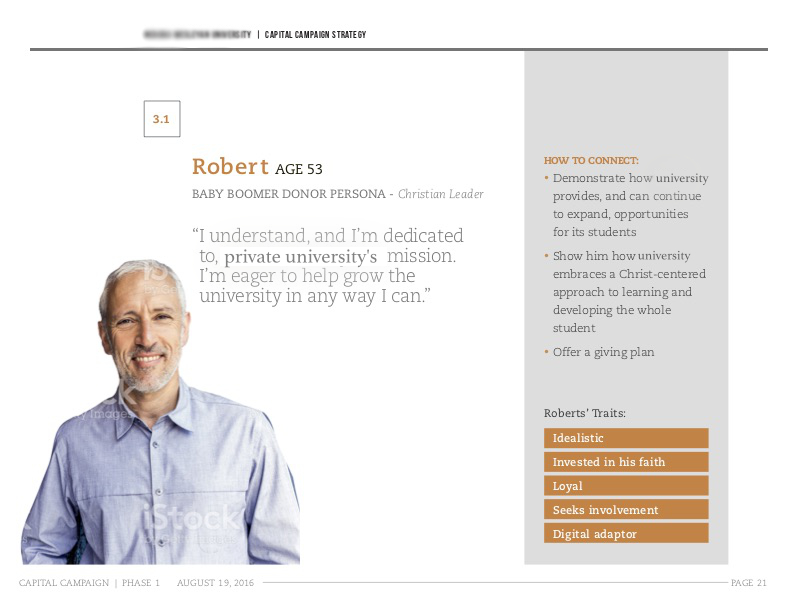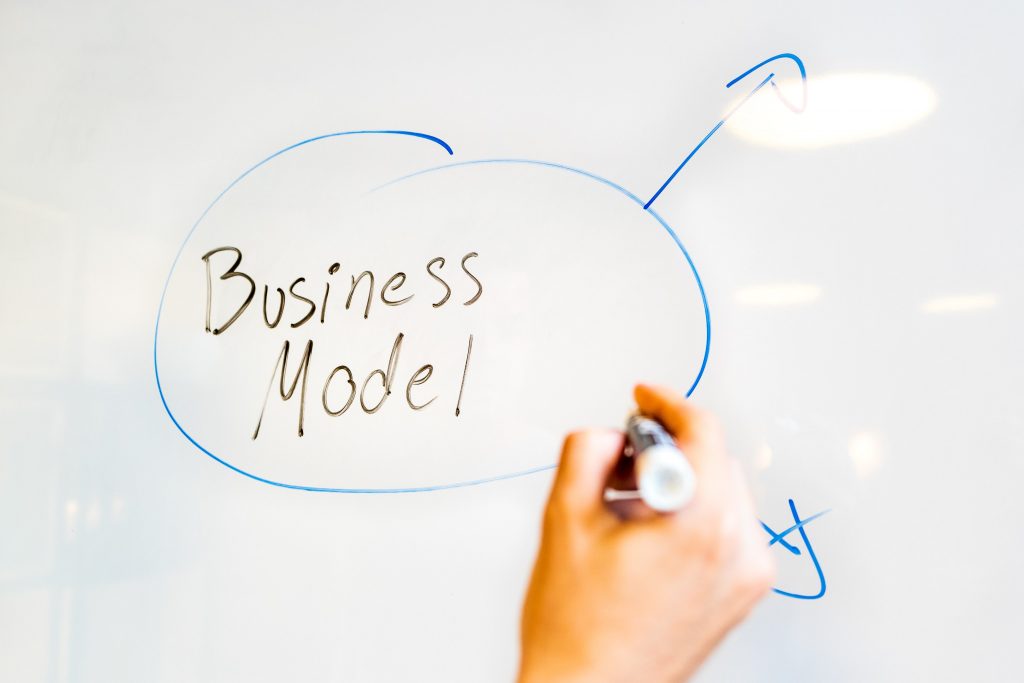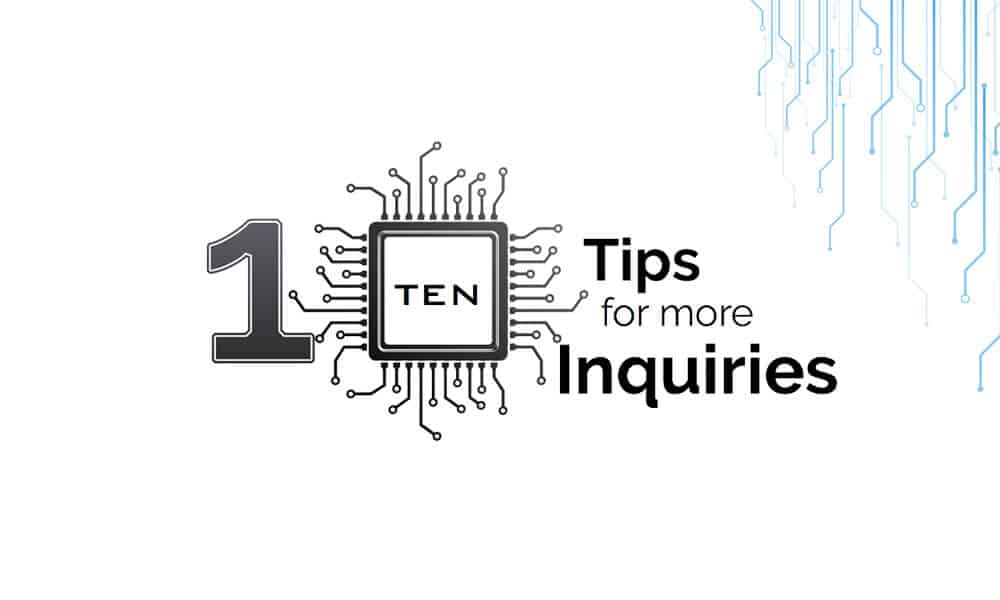What are the best marketing personas for enrollment marketing? Here’s a guide to creating your enrollment marketing personas. Enrollment marketing personas are profiles of imaginary persons who represent your audience.
They are a composite character made up of all the general traits that you know about your target audience(s) based on the information that you have in your files and some strategic guesses on your part.


Here’s an example of an enrollment marketing persona we created for a private university client. If you’re an independent school, your enrollment marketing personas should still include a lot of the same information.
Enrollment marketing personas help make your marketing messages resonate deeply with your audiences.
Enrollment marketing personas put a human face on the data to help marketers better understand buying triggers and move audiences towards those desired behaviors.
And for creative activities like copywriting or graphic design, having a person in mind, even if it’s a fictitious person, is extremely helpful when making creative decisions.
For example, if you were going to write a marketing piece for our persona, Robert, you wouldn’t want to use the expression “this is going to be lit” to express the idea that something is exciting. A man his age probably wouldn’t talk that way.
And when you’re designing the graphic layout for Robert, you wouldn’t set your font size below 12 pt, because Robert’s eyes will not appreciate having to squint to read your words.
Having an enrollment marketing persona for Robert means that you don’t have to have mountains of policies telling your creatives and executives how they should communicate to your audiences – all of these details are expressed in the persona.
With personas–distributed and visible to all your teams–everyone can quickly and easily craft content that is targeted specifically for your audience.
Use Data to Build Your Enrollment Marketing Personas
You might be tempted to throw your personas together quickly because you feel you know them intuitively. I mean, everybody knows that we’re mainly marketing to 16 – 20 year-old Generation Z students, right?
That may be true, but not all Generation Z students are the same.
Your “gut instinct” or assumption might be wrong. This can happen for several reasons.
Different regions have different cultures and socio-economic backgrounds to take into consideration.
A Generation Z prospective student in your region won’t respond to the same marketing messages that a Gen Z student in another region would.
This is especially true if your prospective students are mainly recruited from rural communities as opposed to urban school districts. Very different audience.
But there’s another growing reason to review your data periodically to ensure your personas accurately reflect your target audiences – changing demographics.
Changing Demographics
According to demographic studies, it’s likely your regional demographics are changing.
Multicultural segments are growing: By 2060, Hispanics will represent almost 30% of the U.S. population, according to the U.S. Census Bureau. With 72% recent growth, Asian Americans are the fastest-growing segment, according to Pew Research. At $1.8 trillion in purchasing power (according to a report by the Selig Center for Economic Growth), African Americans set the trends for young consumers.” – Kerux Group
If you rely on your best guess for crafting your enrollment marketing personas, chances are you’ll miss the cultural shifts that are happening all over the U.S. Your region might have more Hispanics than you thought, or it might have more first-generation college students than you realized.
These insights would certainly change how you’d write your website content, email campaigns, and other marketing pieces.
It’s important to consult your own data and other data sources before creating your personas.
Typical Admissions Data You Can Use
There are lots of data you could use to create your enrollment marketing personas, but here’s where I recommend you start:
- Age (traditional, non-traditional)
- SAT/ACT Scores
- GPA Statistics
- Class Rank
- Household Income
- Extracurricular Activities
- Location
Personas are the stories your data is trying to tell you.
Learn to see your data (like the ones I listed above) as stories waiting to be told, and you’ll be amazed by what you learn.
When you begin writing your personas, you’ll be imagining the life and feelings of the individuals you are trying to reach with your marketing message.
You’ll realize where they go for answers. You’ll discover what channels and platforms they use to get their info. You’ll see who they trust and who they avoid.
These are all insights into your audience that you simply can’t get from a data table. But you can glean these insights from the stories around your data.
Since we’ve talked enough about diving into your data to find the stories that will define your marketing personas, I think it’s safe to go to some examples.
Just don’t copy and paste these profile types into your enrollment marketing strategy assuming they will work for you. Start here, but refine them with the data that you have.
Here’s a list I previously put together of common enrollment marketing personas and the groups they fell under.
Examples of Enrollment Marketing Personas
The “Customer”
- The traditional student
- The non-traditional student or adult student
- The graduate student
The “Influencers”
- Moms and Dads
- Siblings
- Coaches
- Guidance Counselors
- Youth Pastors
- Teachers
- Friends
- Upperclassmen
And, of course, don’t forget to create personas for your advancement or development strategy like…
- Young donors & alumni
- New donors
- Recurring donors
- Legacy donors
- Major donors
- Mid-level donors
- Grant makers
Chances are you won’t need every single one of these personas. In fact, if you have more personas than your marketing team can handle, it can be counter-productive.
So how many personas do you need?
Depends on your marketing strategy. Most of the time, you’ll only need to write out personas for the constituents that fit the objectives of your marketing plan.
Also, if you find your team writing messaging or creating content for a specific group of people over and over again, then you should have an official persona mapped out for that group.
Remember, too, that crafting marketing personas isn’t an exact science.
It takes practice to see all of the motivations, cultural factors, and opportunities by just looking at spreadsheets from a database.
Writing marketing personas is the art of analyzing data and then making good guesses — and then revising them as you get better information.
And if you aren’t seeing the results you need from your marketing, consider revisiting or refining your personas. They should be dynamic until the point you see consistent results from your messaging.
Next Step: Schedule a personas brainstorm meeting.
A great next step you can take is to pull your marketing and/or development team together into a brainstorming meeting.
Make sure your data team is represented as well to present the data sets that you have.
Then, it’s time to start crafting stories about the people your data refers to. Pull photos and post them in a character sketch of the personas you’re creating. Then, share the new personas with your marketing team.
Have fun with this, and don’t let the brainstorming get so complicated that you don’t pull the trigger.
Get the main enrollment marketing personas that your team needs posted quickly so you can get to work creating irresistible content for your audiences.
Featured image by Andrey Popov via Adobe Stock
Click here to read this article on the Caylor Solutions website.


![[WEBINAR] Admissions and Marketing Strategies in Uncertain Times](https://www.schoolhouse.agency/wp-content/uploads/2021/08/WEBINAR-Admissions-and-Marketing-Strategies-in-Uncertain-Times-1024x538.jpg)


